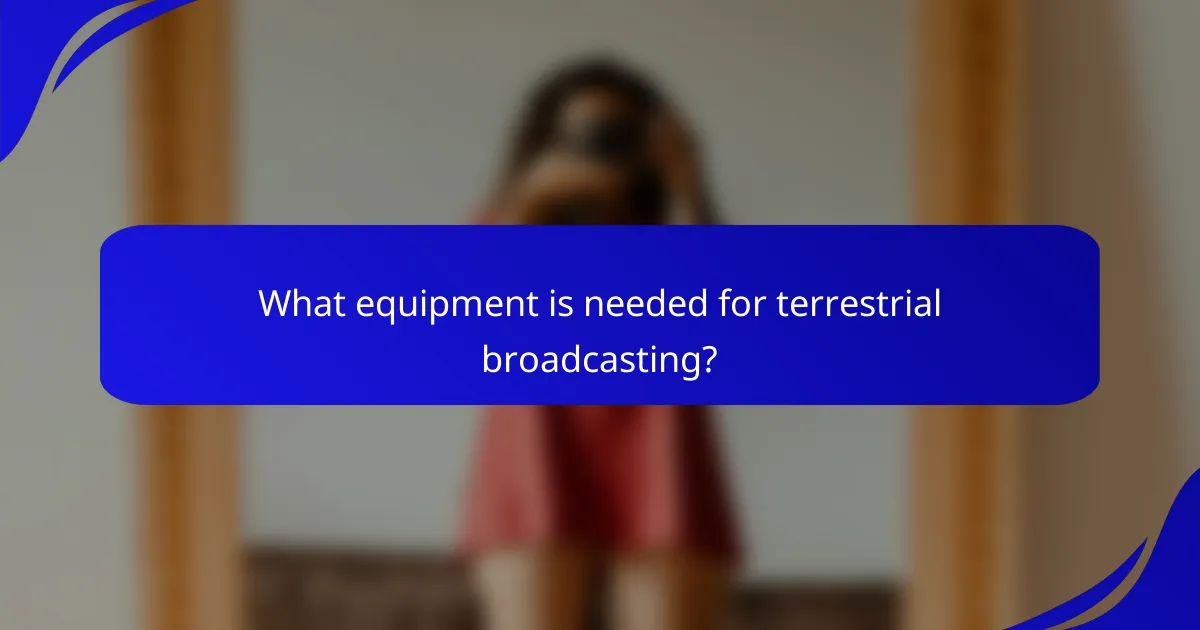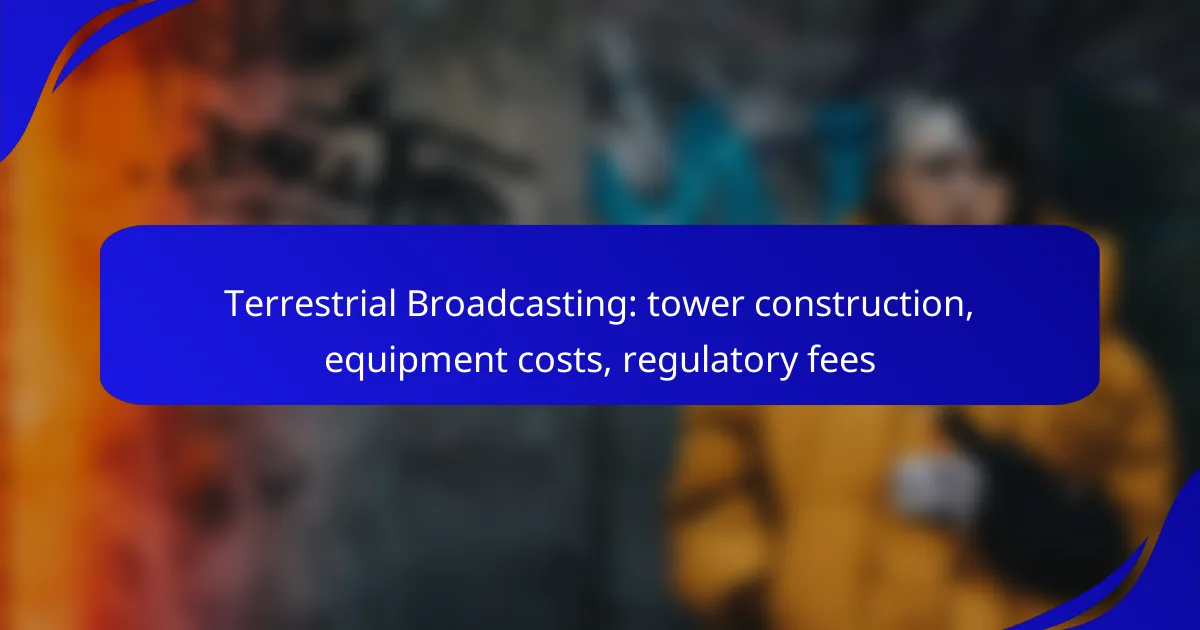Terrestrial broadcasting involves significant investment in tower construction, specialized equipment, and regulatory compliance. The costs for building broadcasting towers can range from hundreds of thousands to several million Canadian dollars, influenced by factors such as location and height. Additionally, essential equipment like transmitters and antennas is crucial for effective signal transmission, while regulatory fees ensure adherence to CRTC guidelines.

What are the costs of terrestrial broadcasting tower construction in Canada?
The costs of constructing terrestrial broadcasting towers in Canada can vary significantly based on several factors, including location, tower height, and the complexity of the installation. Generally, the total expenses can range from hundreds of thousands to several million Canadian dollars.
Average construction costs
The average construction costs for a terrestrial broadcasting tower in Canada typically fall between CAD 250,000 and CAD 1,000,000. This range accounts for basic structures, including materials, labor, and necessary equipment. More advanced towers with specialized features can exceed this range significantly.
Factors influencing costs
Regulatory fees and permits also play a crucial role. Obtaining the necessary approvals from local authorities and adhering to safety regulations can add to the overall costs, sometimes requiring additional engineering assessments or environmental studies.
Regional cost variations

What equipment is needed for terrestrial broadcasting?
Terrestrial broadcasting requires a combination of specialized equipment to transmit signals effectively. Key components include transmitters, antennas, and audio/video processing gear, each playing a crucial role in delivering quality broadcasts.
Essential broadcasting equipment
The fundamental equipment for terrestrial broadcasting includes transmitters, which convert audio and video signals into radio waves, and antennas that broadcast these signals over a wide area. Additionally, studios require audio mixers, video switchers, and encoders to prepare content for transmission. Backup systems, such as generators and redundant transmitters, are also vital to ensure uninterrupted service.
Recommended brands and models
For transmitters, brands like Harris, Nautel, and Rohde & Schwarz are widely recognized for their reliability and performance. Antennas from manufacturers such as Shively Labs and Jampro are popular choices for their durability and range. In the audio and video processing category, brands like Avid and Blackmagic Design offer high-quality mixers and switchers that are favored in the industry.
Equipment cost breakdown
The cost of terrestrial broadcasting equipment can vary significantly based on the scale of the operation. Basic transmitters may start in the low thousands of USD, while high-powered models can exceed tens of thousands. Antennas typically range from a few hundred to several thousand USD, depending on specifications. Additional costs for studio equipment, installation, and regulatory fees should also be factored in, potentially bringing total initial investments into the six-figure range.

What are the regulatory fees for terrestrial broadcasting in Canada?
Regulatory fees for terrestrial broadcasting in Canada can vary significantly based on the type of service and the specific licensing requirements. These fees are essential for maintaining compliance with the Canadian Radio-television and Telecommunications Commission (CRTC) regulations.
Typical regulatory fees
Typical regulatory fees for terrestrial broadcasting in Canada can range from a few thousand to tens of thousands of Canadian dollars, depending on the size and scope of the broadcasting operation. For instance, a small community radio station might pay around CAD 1,000, while a larger commercial broadcaster could face fees exceeding CAD 20,000.
Additionally, annual fees may apply, which are often based on revenue generated by the broadcasting service. This means that as a broadcaster grows, their regulatory costs can increase proportionally.
Licensing requirements
To operate a terrestrial broadcasting service in Canada, obtaining a license from the CRTC is mandatory. The licensing process involves submitting an application that outlines the proposed service, including technical specifications and programming content.
Broadcasters must also demonstrate compliance with Canadian content regulations and other broadcasting standards. This often requires a detailed understanding of the CRTC’s policies and may involve legal assistance to navigate the complexities of the application process.
Impact of regulations on costs
Regulations significantly impact the overall costs of establishing and maintaining a terrestrial broadcasting service. Compliance with technical standards, such as signal quality and coverage area, can necessitate substantial investment in equipment and infrastructure.
Moreover, ongoing regulatory fees and potential fines for non-compliance can strain budgets, particularly for smaller broadcasters. It is crucial for prospective broadcasters to budget for these costs early in their planning to avoid financial pitfalls later on.

How do tower construction and equipment costs compare?
Tower construction and equipment costs are critical factors in establishing terrestrial broadcasting services. Generally, construction expenses can be substantial, often ranging from tens of thousands to several million dollars, while equipment costs can vary widely based on technology and specifications.
Cost comparison overview
The costs associated with tower construction and broadcasting equipment can differ significantly. Tower construction typically involves site preparation, materials, labor, and permits, which can accumulate quickly. In contrast, equipment costs include transmitters, antennas, and related technology, which can also be high but may offer more variability based on the desired broadcasting range and quality.
For example, a basic tower might cost around $100,000 to $500,000, while the necessary broadcasting equipment could range from $50,000 to over $300,000 depending on the specifications and brand. This highlights the importance of careful budgeting and planning.
Budgeting for construction vs. equipment
When budgeting for tower construction versus equipment, prioritize understanding the specific needs of your broadcasting service. Construction costs are often fixed and can be influenced by local regulations and site conditions, while equipment costs can be more flexible, allowing for upgrades or adjustments based on budget constraints.
It is advisable to allocate approximately 60-70% of your budget for tower construction and 30-40% for equipment, although this can vary based on project specifics. Consider potential ongoing costs such as maintenance and regulatory fees, which can impact overall budgeting decisions.

What are the prerequisites for starting a terrestrial broadcasting project?
Starting a terrestrial broadcasting project requires careful planning, including site selection, understanding regulatory requirements, and budgeting for equipment and construction costs. These elements are crucial for ensuring compliance and operational success.
Site selection criteria
Choosing the right site for a terrestrial broadcasting tower is essential for maximizing coverage and signal quality. Key factors include geographic elevation, proximity to target audiences, and minimal interference from surrounding structures or natural obstacles.
Consideration of zoning laws and land use regulations is also critical. Ensure the site complies with local regulations and has access to necessary utilities like power and internet connectivity.
Permitting process
The permitting process for terrestrial broadcasting involves obtaining various approvals from local, state, and federal authorities. This can include environmental assessments, construction permits, and compliance with the Federal Communications Commission (FCC) regulations in the United States.
It’s advisable to engage with local government early in the process to understand specific requirements and timelines. Delays in permitting can significantly impact project schedules, so thorough preparation and timely submissions are key to a smooth process.

What emerging trends are shaping terrestrial broadcasting in Canada?
Emerging trends in terrestrial broadcasting in Canada are largely influenced by technological advancements, regulatory changes, and market growth opportunities. These factors are transforming how broadcasters operate and engage with audiences, leading to a more dynamic broadcasting landscape.
Technological advancements
Technological advancements are significantly enhancing the capabilities of terrestrial broadcasting. Innovations such as digital transmission, high-definition broadcasting, and the integration of Internet Protocol (IP) technologies allow for improved signal quality and more efficient use of bandwidth.
Broadcasters are increasingly adopting cloud-based solutions for content management and distribution, which can reduce operational costs and improve flexibility. Additionally, the rise of mobile broadcasting technologies enables content to be delivered to viewers on various devices, expanding audience reach.
Regulatory changes
Regulatory changes in Canada are shaping the framework within which terrestrial broadcasters operate. The Canadian Radio-television and Telecommunications Commission (CRTC) regularly updates policies to address the evolving media landscape, including requirements for local content and accessibility.
Broadcasters must stay informed about these regulations, as compliance can impact operational costs and content strategies. For instance, changes in licensing fees or content quotas can affect budgeting and programming decisions.
Market growth opportunities
Market growth opportunities in terrestrial broadcasting are emerging from increased demand for diverse content and local programming. As audiences seek unique and relevant content, broadcasters can capitalize on niche markets and underserved demographics.
Collaboration with local producers and community organizations can enhance content offerings and strengthen viewer loyalty. Additionally, exploring partnerships with digital platforms can provide new revenue streams and broaden audience engagement.
